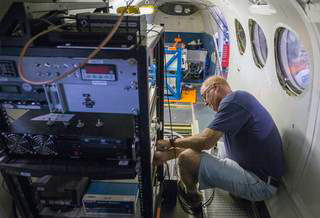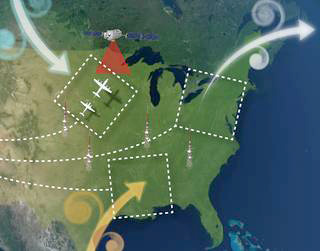Beginning this month, NASA will have its King Air B200 and a C-130H participate in airborne experiments to understand the sources of two specific greenhouse gases and how they cycle into and out of the atmosphere. The name of the study is Atmospheric Carbon and Transport-America (ACT-America), a multi-year project to study concentrations of carbon dioxide and methane in relation to weather systems.
“Carbon dioxide and methane are the two most important long-lived greenhouse gases in the atmosphere,” said Ken Davis, ACT-America principal investigator from Pennsylvania State University, University Park. “We have a very difficult time inferring important sources and sinks of these gases, including uptake of carbon dioxide by the biosphere, and emission of methane from a variety of human and biological sources. We hope to improve our ability to measure those sources and sinks today, which should enable improvements in the management and simulation of future climate.”
The data the program collects will fill in the details of how the gases are moved by weather systems, information that will help scientists interpret the long-term greenhouse gas observations more accurately.

Current observation relies on a ground towers and more recently space satellites. These satellites provide significantly more observations and cover much more of the Earth’s surface, but they cannot sample continuously in any one location or see through clouds.
“The ability of the ACT-America campaign to help bridge the spatial scales between satellite and ground observations, as well as to look in detail about how weather patterns contribute to changes in the distributions of carbon dioxide and methane makes it a unique addition to the global effort to understand the sources and sinks of greenhouse gases,” said Michael Freilich, director of the Earth Science Division at NASA Headquarters, Washington.
The ACT-America campaign will use instruments on NASA’s C-130H and King Air B-200 aircraft. The C-130H and B-200 will fly below OCO-2 collecting data that will be compared with satellite data collected at the same time and place. The campaign team includes researchers and flight crews collecting data in the air, and scientists on the ground synthesizing that information into computer models.
The first flights will be based out of NASA’s Langley Research Center, Hampton, Virginia, and Wallops Flight Facility, Wallops Island, Virginia. Subsequent flights this summer will be based in Lincoln, Nebraska, and Shreveport, Louisiana.

This summer’s flights are the first of five field campaigns planned during the study, each lasting six weeks. ACT-America is one of six airborne studies funded by the most recent round of NASA’s Earth System Science Pathfinder Program.
NASA notes their mission is to collect data from space, air, land and sea to increase our understanding of our home planet, improve lives and safeguard our future.

